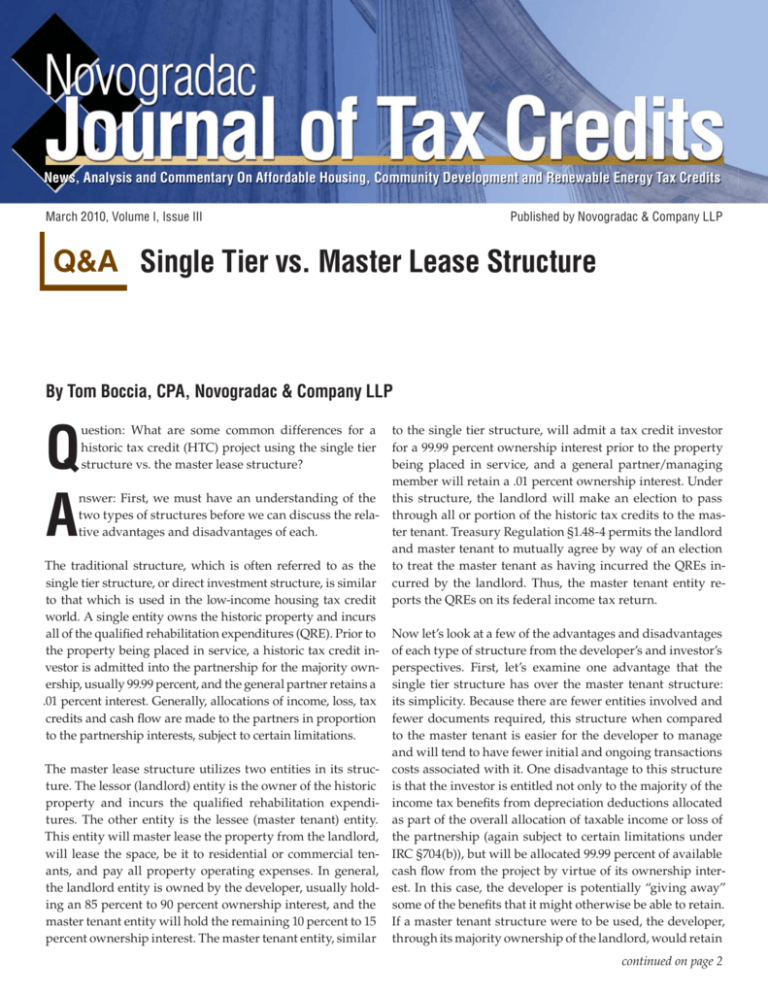
News, Analysis and Commentary On Affordable Housing, Community Development and Renewable Energy Tax Credits
March 2010, Volume I, Issue III
Published by Novogradac & Company LLP
Q&A Single Tier vs. Master Lease Structure
By Tom Boccia, CPA, Novogradac & Company LLP
Q
A
uestion: What are some common differences for a
historic tax credit (HTC) project using the single tier
structure vs. the master lease structure?
nswer: First, we must have an understanding of the
two types of structures before we can discuss the relative advantages and disadvantages of each.
to the single tier structure, will admit a tax credit investor
for a 99.99 percent ownership interest prior to the property
being placed in service, and a general partner/managing
member will retain a .01 percent ownership interest. Under
this structure, the landlord will make an election to pass
through all or portion of the historic tax credits to the master tenant. Treasury Regulation §1.48-4 permits the landlord
and master tenant to mutually agree by way of an election
to treat the master tenant as having incurred the QREs incurred by the landlord. Thus, the master tenant entity reports the QREs on its federal income tax return.
The traditional structure, which is often referred to as the
single tier structure, or direct investment structure, is similar
to that which is used in the low-income housing tax credit
world. A single entity owns the historic property and incurs
all of the qualified rehabilitation expenditures (QRE). Prior to Now let’s look at a few of the advantages and disadvantages
the property being placed in service, a historic tax credit in- of each type of structure from the developer’s and investor’s
vestor is admitted into the partnership for the majority own- perspectives. First, let’s examine one advantage that the
ership, usually 99.99 percent, and the general partner retains a single tier structure has over the master tenant structure:
.01 percent interest. Generally, allocations of income, loss, tax its simplicity. Because there are fewer entities involved and
credits and cash flow are made to the partners in proportion fewer documents required, this structure when compared
to the partnership interests, subject to certain limitations.
to the master tenant is easier for the developer to manage
and will tend to have fewer initial and ongoing transactions
The master lease structure utilizes two entities in its struc- costs associated with it. One disadvantage to this structure
ture. The lessor (landlord) entity is the owner of the historic is that the investor is entitled not only to the majority of the
property and incurs the qualified rehabilitation expendi- income tax benefits from depreciation deductions allocated
tures. The other entity is the lessee (master tenant) entity. as part of the overall allocation of taxable income or loss of
This entity will master lease the property from the landlord, the partnership (again subject to certain limitations under
will lease the space, be it to residential or commercial ten- IRC §704(b)), but will be allocated 99.99 percent of available
ants, and pay all property operating expenses. In general, cash flow from the project by virtue of its ownership interthe landlord entity is owned by the developer, usually hold- est. In this case, the developer is potentially “giving away”
ing an 85 percent to 90 percent ownership interest, and the some of the benefits that it might otherwise be able to retain.
master tenant entity will hold the remaining 10 percent to 15 If a master tenant structure were to be used, the developer,
percent ownership interest. The master tenant entity, similar through its majority ownership of the landlord, would retain
continued on page 2
NOVOGRADAC JOURNAL OF TAX CREDITS
continued from page 1
the majority of the project’s cash flow and potential tax losses.
Novogradac Journal of Tax Credits
Editorial Board
PUBLISHER
Looking at the master tenant structure, one primary advantage is
that the mandatory basis reduction of the depreciable property and
the HTC investor’s basis in its partnership interest, which is required
under a single tier structure, does not apply to a master tenant structure in which the HTC is “passed through” to the master tenant. This
is important to the developer because now the landlord entity will
generate larger depreciation deductions, most of which will be allocated to the developer. The importance of this to the HTC investor
is that it will not have to reduce its basis by the amount of the HTC.
This is key because now the HTC investor under the master tenant
structure will have a much higher basis, which has a significant positive impact in reducing any potential capital gain or increasing any
capital loss to the investor at the time it sells its ownership interest in
the project after the HTC compliance period.
Michael J. Novogradac, CPA
EDITOR
Jane Bowar Zastrow
MANAGING EDITOR
Alex Ruiz
STAFF WRITERS
Jennifer Dockery
Jennifer Hill
TECHNICAL EDITORS
Robert S. Thesman, CPA
James R. Kroger, CPA
Owen P. Gray, CPA
Thomas Boccia, CPA
Daniel J. Smith, CPA
CONTRIBUTING WRITERS
These are just a few of the advantages and disadvantages of the
single tier structure and the master lease structure. When given
all the facts and circumstances of a transaction, care should be
taken in analyzing what constitutes the best structure. Working
with your tax advisor is critical to making the best decision.
Douglas Banghart
Jing Chen, CPA
Brandi Day
Brad Elphick, CPA
Drew Geolot
Tony Grappone, CPA
John Leith-Tetrault
Derek Luz
Wayne Michael, CPA
Forrest David Milder
Buzz Roberts
Thomas Stagg, CPA
Bentley D. Stanton, CPA
PRODUCTION
This article first appeared in the March 2010 issue of the Novogradac
Journal of Tax Credits. © Novogradac & Company LLP 2010 - All Rights
Reserved
www.novoco.comMarch 2010
2
Notice pursuant to IRS regulations: Any U.S. federal tax advice contained
in this article is not intended to be used, and cannot be used, by any taxpayer for the purpose of avoiding penalties under the Internal Revenue
Code; nor is any such advice intended to be used to support the promotion or marketing of a transaction. Any advice expressed in this article
is limited to the federal tax issues addressed in it. Additional issues may
exist outside the limited scope of any advice provided – any such advice
does not consider or provide a conclusion with respect to any additional
issues. Taxpayers contemplating undertaking a transaction should seek
advice based on their particular circumstances.
This editorial material is for informational purposes only and should not be
construed otherwise. Advice and interpretation regarding property compliance or any other material covered in this article can only be obtained from
your tax advisor. For further information visit www.novoco.com.
Special offer for E-newsletter
only subscribers:
Click here for 20% off an introductory
12-Month Print Subscription to the
Journal of Tax Credits.
Jesse Barredo
James Matuszak
Novogradac Journal of Tax Credits
Information
Address all correspondence and
editorial submissions to:
Jane Bowar Zastrow / 415.356.8034
Address inquiries regarding
advertising opportunities to:
Emil Bagalso / 415.356.8037
Editorial material in this publication is for informational
purposes only and should not be construed otherwise.
Advice and interpretation regarding the low-income
housing tax credit or any other material covered in this
publication can only be obtained from your tax advisor.
© Novogradac & Company LLP
2010 All rights reserved.
ISSN 2152-646X
Reproduction of this publication in whole or in part in any
form without written permission from the publisher is
prohibited by law.









